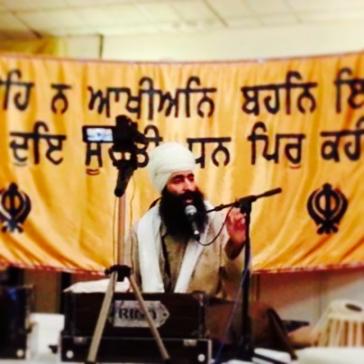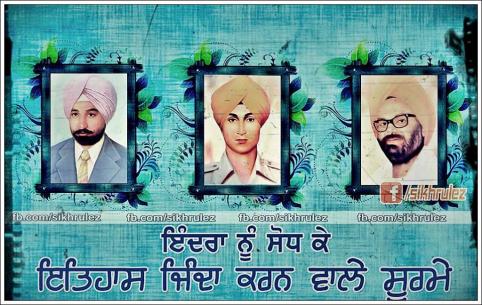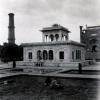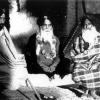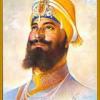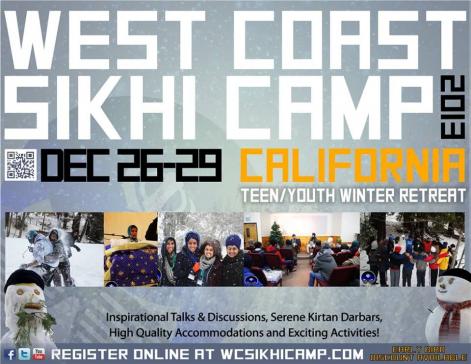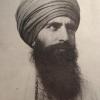Search the Community
Showing results for tags 'sikhi'.
-
Waheguru Ji Ka Khalsa, Waheguru Ji Ki Fateh I'm new to Sikhi and trying to learn as much as possible Do you know where can I find good resources? I already know about some sikhi answers pages, but are there some online sikh courses/schools or live chats? Thanks
-
Wahiguroojikakhalsa!Wahiguroojikifateh! 8 new Katha audios by Bhai Sukha Singh have been added to GurshabadVeechar.com, including Katha from Suraj Prakash, Bhai Sahib Gurdaas Jee and Shabads from Sahib Sri Guru Granth Sahib Ji! Follow the link below to listen ---> http://gurshabadveechar.com/andromeda/andromeda.php?q=f&f=%2FKatha sada ang sange Gurshabad Veechar Team
-
3
-
- bhai sukha singh
- katha
- (and 8 more)
-
ਭੈਰਉ ਮਹਲਾ ੫ ਘਰੁ ੧ भैरउ महला ५ घरु १ Bẖairo mėhlā 5 gẖar 1 Bhairao, Fifth Mehl, First House: ੴ ਸਤਿਗੁਰ ਪ੍ਰਸਾਦਿ ॥ ੴ सतिगुर प्रसादि ॥ Ik▫oaʼnkār saṯgur parsāḏ. One Universal Creator God. By The Grace Of The True Guru: ਸਗਲੀ ਥੀਤਿ ਪਾਸਿ ਡਾਰਿ ਰਾਖੀ ॥ सगली थीति पासि डारि राखी ॥ Saglī thīṯ pās dār rākẖī. Setting aside all other days, it is said, ਅਸਟਮ ਥੀਤਿ ਗੋਵਿੰਦ ਜਨਮਾ ਸੀ ॥੧॥ असटम थीति गोविंद जनमा सी ॥१॥ Astam thīṯ govinḏ janmā sī. ||1|| that the Lord was born on the eighth lunar day. ||1|| ਭਰਮਿ ਭੂਲੇ ਨਰ ਕਰਤ ਕਚਰਾਇਣ ॥ भरमि भूले नर करत कचराइण ॥ Bẖaram bẖūle nar karaṯ kacẖrā▫iṇ. Deluded and confused by doubt, the mortal practices falsehood. ਜਨਮ ਮਰਣ ਤੇ ਰਹਤ ਨਾਰਾਇਣ ॥੧॥ ਰਹਾਉ ॥ जनम मरण ते रहत नाराइण ॥१॥ रहाउ ॥ Janam maraṇ ṯe rahaṯ nārā▫iṇ. ||1|| rahā▫o. The Lord is beyond birth and death. ||1||Pause|| ਕਰਿ ਪੰਜੀਰੁ ਖਵਾਇਓ ਚੋਰ ॥ करि पंजीरु खवाइओ चोर ॥ Kar panjīr kẖavā▫i▫o cẖor. You prepare sweet treats and feed them to your stone god. ਓਹੁ ਜਨਮਿ ਨ ਮਰੈ ਰੇ ਸਾਕਤ ਢੋਰ ॥੨॥ ओहु जनमि न मरै रे साकत ढोर ॥२॥ Oh janam na marai re sākaṯ dẖor. ||2|| God is not born, and He does not die, you foolish, faithless cynic! ||2|| ਸਗਲ ਪਰਾਧ ਦੇਹਿ ਲੋਰੋਨੀ ॥ सगल पराध देहि लोरोनी ॥ Sagal parāḏẖ ḏėh loronī. You sing lullabies to your stone god - this is the source of all your mistakes. ਸੋ ਮੁਖੁ ਜਲਉ ਜਿਤੁ ਕਹਹਿ ਠਾਕੁਰੁ ਜੋਨੀ ॥੩॥ सो मुखु जलउ जितु कहहि ठाकुरु जोनी ॥३॥ So mukẖ jala▫o jiṯ kahėh ṯẖākur jonī. ||3|| Let that mouth be burnt, which says that our Lord and Master is subject to birth. ||3|| ਜਨਮਿ ਨ ਮਰੈ ਨ ਆਵੈ ਨ ਜਾਇ ॥ जनमि न मरै न आवै न जाइ ॥ Janam na marai na āvai na jā▫e. He is not born, and He does not die; He does not come and go in reincarnation. ਨਾਨਕ ਕਾ ਪ੍ਰਭੁ ਰਹਿਓ ਸਮਾਇ ॥੪॥੧॥ नानक का प्रभु रहिओ समाइ ॥४॥१॥ Nānak kā parabẖ rahi▫o samā▫e. ||4||1|| The God of Nanak is pervading and permeating everywhere. ||4||1|| What does the sangat think ?
- 7 replies
-
1
-
- avtaarvaad
- sikhi
-
(and 1 more)
Tagged with:
-
Vaheguruji ka khalsa Vaheguru ji ki fateh Today on the 6th Jan, 1989 is the Shaheedi divas of Bhai Satwant Singh & Bhai Kehar Singh - Defenders of the Faith Please do Ardas to Maharaaj to send more Gursikhs like Bhai Satwant Singh Ji and Bhai Kehar Singh Ji to help our Nation. We will forever have the shaheeds in our hearts. http://www.neverforget84.com/shaheeds/shaheed-bhai-satwant-singh Parnaam Shaheeda Nu Khalistan Zindabad
-
WAHEGURU JI KA KHALSA WAHEGURU JI KI FATEH ADMIN ji, benti, can we please put a ban on racist language. Terms such as "p*ki" etc which seem to be used on the regular on this forum. In the same other profane terms are banned, can a ban be applied to these racist terms please? * P*ki: Chiefly British Offensive Slang. Used as a disparaging term for a person of Pakistani or South Asian birth or descent. The term may be used amongst people of Pakistani decent, however, what right does that give us to use the term? And those who do use it in a derogatory manner, are only associating themselves with those people. As a Sikh forum, one of very few, this platform for healthy discussion attracts people from all walks of life. Sikhs wanting to further their knowledge of Sikhi and non-Sikhs wanting to gain an understanding of Sikhs and Sikhi, respectively. Currently, there are two discussions where profane language is being used. Is this the image we want to create of Sikhs and Sikhi alike? There are children using this site. Yes, this is a forum and therefore discussions can not always be restricted. However, in the same way that other profanity is banned, words such as the "F" word etc, racist terms should also be banned. In the end, it comes down to us, the users of this amazing platform, to watch what we say. In an ideal world, Admin would not need to ban any words. We must ask ourselves, is this what we have been taught by our Guru Sahib? And is this the image we want to create of ourselves? We are Sikhs. Children of our father, Dasam Pita, Guru Gobind Singh Ji Maharaaj. Pul chuk muaf ji WAHEGURU JI KA KHALSA WAHEGURU JI KI FATEH
-
Waheguru Here is the plan for 2014
-
Few days back.... I got one question in my mind How does a person react if he is growing in spirituality... that is for sure that with reciting the name you are enhancing your spiritual power, but how can you judge it. I feel changes in myself a lot many times and I even feel relaxed and satisfied with my self.. a kind of peace is developing... Is it this, the sign of Spiritual growth? and yes i feel more relaxed while doing simran as compared to doing path.. this happened few days back.. Can anyone help me out to understand this situation?
-
Humble Benti to Everyone to watch it once. Great Advice for Khalsa Panth.
- 5 replies
-
- basicsofsikhi
- gurbakshsinghkhalsa
-
(and 3 more)
Tagged with:
-
Vaheguru Ji Ka Khalsa Vaheguru Ji Ki Fateh I had the privilege to attend last year and it was amazing. Spread the word, a lot of great speakers and sangat with a beautiful campsite.
- 5 replies
-
8
-
- wcsc
- california
-
(and 5 more)
Tagged with:
-
Anno 2003 - Hawayein got banned. Anno 2013 - They tried to ban Sadda Haq but failed, soon movies like 1984 Punjab and Kaum de Heere (about Shaheed Beant and Satwant Singh) are also releasing. Inderjit Nikku - he was a mona but he grew back his kesh after reading more into Sikhi. He still trims his beard but Waheguru willing he will grow even closer to the Guru. KS Makhan - became amritdhari. Jassi Jasraj - campaigned against vulgarity and started wearing dastaar, singing about Panthic matters. Raj Kakra - sung many Panthic songs and started wearing a dastaar. AS Kang - became kesdhari. Your thoughts?
-
Dear Sadh Sangat ji ਵਾਹਿਗੁਰੂ ਜੀ ਕਾ ਖਾਲਸਾ ਵਾਹਿਗੁਰੂ ਜੀ ਕੀ ਫਤਿਹ You might came across in the media, that Google is setting up a function called Google Helpout, which is based on Google Hangout. People will be able to ask for help etc. My question is how can we use this tool for the future for distributing Sikhi and is there anyone who is already using it for giving santhiya, teaching tabla, vaja, Punjabi etc. Google Hangout is able as far as I know to communicate with 10 people. However you can also set it up as a public conversation and everyone in the world can join the stream. http://www.youtube.com/watch?v=K-VFC9AQM1k
-
- google hangout
- teaching
- (and 5 more)
-
Ghal Kamaye Kich Hathon Dei | Nanak Rah Pachaney Sey || One who earns with honest means and gives part of it to the needy , only has recognized the true way sayeth Nanak. Sharing is a big part of sikh philosophy, however we should be prudent in choosing who is worthy of our chartiable gifts - Akli par ke boojheye Akli keeje Daan || Exercise your wisdom in reading and in charity. (Usually Daan as per hindu mat was only for brahmins who were already well fed ) Sey Nar Kya Puraan sun Keena | Ann Pachati Bhagat Na Upaji Bhookhei Daan Na Deena || What has one gained by listening to puranas if he has not immersed himself in unwavering worship and has not given food to the hungry. Here puranas are symbolic of all religious scriptures (including SGGS) ... the gist is if one does his nitnem but turns his head away when he sees needy/hungry people , all of his recitations are futile. If sangat knows more tuks on this topic please share.
-
Celebrating Bandi Chor Divas, Kent Kirtan Society (UK) Presents Kathavachak Bhai Sahib Singh (Canada Wale) UK Tour 20th Oct-3rd Nov: Sun 20 Oct: 12-12:45pm Gurdwara Sikh Sangat, Harley Grove, Bow, London, E3 2AT 2:45-3:30pm Gurdwara Guru Nanak Darbar, King Street, Southall, UB2 4DQ Mon 21-Thurs 24 Oct: 11am-12pm Sri Guru Singh Sabha Gurdwara, Havelock Road, Southall, UB2 4NP 7:30-8:30pm Sri Guru Singh Sabha Gurdwara, Park Avenue. Southall, UB1 3AG Fri 25- Sun 27 Oct: 8-9pm Nanaksar Thath Isher Darbar, Mander Street, Wolverhampton, WV3 0JZ Sun 27 Oct: 11am-12pm Gurdwara Bebe Nanaki Ji, 189 Rookery Road, Birmingham, B21 9PX 12:15-1:30pm Ramgharia Sikh Temple, 51 Graham Street, Birmingham, B1 3JR 2:30-3:30pm Guru Har Rai Sahib Gurdwara, 128 High St West Bromwich, B70 6JW Mon 28 & Tues 29 Oct: 7-8pm The Sikh Temple, 192 Chapeltown Road, Leeds, LS7 4HZ Wed 30 Oct: 7:30-9pm Gurdwara Khalsa Mero Roop Hai Khas, West Way, South Shields, NE33 4SR Thurs 31 Oct: 7:30-9pm Sri Guru Singh Sabha Gurdwara, Cottenham Street, Newcastle, NE4 5QU Fri 1 Nov: 6:30-8pm Gurdwara Baba Budha Sahib Ji, 24 Gladstone Street, Nottingham, NG7 6GA Sat 2 Nov: 7:30-8:45pm Central Gurdwara, 32 Derby Street, Manchester, M8 8RY Sun 3 Nov: 11am-12:20pm Guru Nanak Gurdwara, 2/20 Tunbridge Street, Preston, PR1 5YP 1:15-2:15pm Sri Guru Gobind Singh Gurdwara, 57 Upper Chorlton Road, Manchester, M16 7RQ 6:15-7:15pm The Sikh Temple, 192 Chapeltown Road, Leeds, LS7 4HZ 8:15-9pm Shri Guru Gobind Singh Ji Sikh Temple, Warren Street, Sheffield, S4 7WT For further info contact: 07403288274/07748803614 or visit www.kentkirtansociety.org
-
- gurbani katha
- uk tour
-
(and 8 more)
Tagged with:
-
Leaving aside any esoteric interpretations and perspectives, why did the purataan Khalsa hunt?
-
Would you like to organise a Sikhi Camp? Free Sikhi Camp Resources available at our Two Servers: http://rajkaregakhalsa.net/downloads.htm and http://sikhee.com/downloads.html RajKaregaKhalsa.Net & Sikhee.com The sites that were first in bringing you http://Youtube.com/Sikhi 33.4 Million views 15800 Subscribers View Gurbani with all of our mp3 downloads so you can easily read translations Translated Videos to easily learn Gurbani Punjabi & Gurmukhi learning resources Presentations, Games, Literature and much, much more... All available for free with no donations accepted in 16 years Raj Karega Khalsa Network
-
it dosent matter what religion u r, aslong as u follow it properly u will be one with god. So is the reason why ppl don't look at sikhi and convert because it says that? can someone help me im very confused
-
Does anyone know any movies like ocean of pearls, that teach good morals about sikhi? I've seen breakaway. But are there any others?
-
The guy who makes these videos on Youtube needs to do lessons in English on the: Sikh Channel, Sangat TV and also other channels, who agrees?
-
WJKK WJKF I'm 15 years old, I've grown up in a non-amritdhari family and my dad cuts his hair. I've kept my kesh my entire life and so has my younger brother. I've been doing kirtan and path for most of my life, my dad has no problems with that. But I wear a dhamalla/gol pagh and my parents don't like that. I don't want to wear the other type of "regular" pagh that he wants me to wear ...my dad tells me dhamlla's make people look uneducated. He also makes me use fixo for my beard, while I want to keep it open. Another problem that I'm facing is my masee (aunt)... wants me to trim my beard! And I've told her I don't want to and never will, but she keeps on annoying me about it. What can I do to get my aunt and my dad to just let me do what I want? Any help would be great. Thanks. WJKK WJKF
-
Guru Nanak Dev Ji's visit to Mecca. Despite rejecting the prevalent sub-continental philosophies surrounding him, Guru Nanak Dev undertook extensive travels in visiting the sites of pilgrimage often associated with his neighboring traditions. He visited Rome to view and dissect the Christian faith, he visited many an eminent Hindu site to dispel prevalent superstitions accepted as spirituality whilst he visited Mecca to dispel the myth of a singular supreme faith. It is his visit to Mecca which has become a matter of extensive debate between Islamic and Sikh scholars. The queries raised by the critics are simple yet confounding to the layman. What truly occurred at Mecca. Did Guru Nanak Dev Ji actually visit the said location? Did he adhere to its tenets as prescribed by Islam? Did he conform his belief in the prophet and his revelation? Or is there a more divergent version to the event. One which narrates the truth in it's entirety and forgoes all notions of the Guru claiming Islam to be his faith? Let us see. The Guru always purported himself to be neutral and entirely indifferent to both the doctrines of Islam and Hinduism. He did not give credence to either of the said faiths being rational in their spiritual perspective and/or capable of liberating an adherent. Islamic scholars have often justified their fraudulent views, regarding the Guru's acceptance of Islam, by quoting several untraceable and more often then not extremely biased and heavily fraudulent sources devoid of any historical logic. These sources, and their so called rationality, are subsequently refuted by the Guru's own writings contained within the Sikh canon and events which transpired in his life. The arguments concerning the Guru's acceptance of Islam are laid as follows: 1.) The Guru paid obeisance to Allah at a mosque in his residential region. Despite such an event transpiring its logic, and course, has been heavily perverted by these pseudo-scholars. The Guru did indeed visit the mosque but for a more divergent reason than is claimed by our neo-scholars. His dictum that the existence of both Hindus and Muslims, as per their stratification, was meaningless in the eyes of the creator and as a result there truly was no distinctive entity defined as Hinduism or even Islam. If he truly had been a Muslim than such a statement would have been apostasy and he himself would have decried and eschewed any notion of citing it. When his ultimatum reached the ears of the regional Islamic authorities they immediately descended on him. In order to make him prove his claim, and potentially see and accept the supremacy of Islam, he was challenged to attend the ritualistic Islamic prayer at the local mosque if he truly abided by his own paragon. The Guru accepted this challenge and traversed to the said mosque. On entering and performing ablution he patiently stood still whilst the prayer was reiterated around him. After the conclusion the authorities approached him and chastised him for his conduct. Why did he not bow and kneel as they had done? They queried from him. The Guru answered with an extensive conundrum, citing the fact that no one truly had their heart in the prayer and as such he was confused as to what to do. Thus he decided to remain standing. When he was heavily criticized due to his blasphemy he provided an extensive insight into the minds of the authorities themselves. They had been concerned with the commercialization and upkeep of their respective horses he delved. This revelation finally exposed the hypocrisy of the ritualistic prayers and their performers. This very event proves the Guru's rejection of Islamic tenets. As per Islam only God (Allah) and his prophet, Muhammad, are allowed insight into the minds of men ('Al-Ghaib'). Thus the Guru's rejection, avoidance of performing a ritualistic prayer and divine insight proves him to be a non-muslim. 2.) The Guru included the Bani of several eminent Islamic saints on his canon. As per history the Guru included the Bani of four "muslim" saints in the Guru Granth Sahib Ji. Despite the label of "muslim" these individuals did not adhere to fundamental Islamic notions (parallel to the Guru and his subsequent successors). Despite using Arabian terminology Sheik Farid gave great credence to the dictums of re-incarnation, a recognition of humanity and the recognition of the metaphysical concept of avatar-hood. Bhagat Sadhna preached the notion of universality and belief in a God who was above any Abrahamic or Hinduistic constraints. Bhagat Bikhan as a sufi purported the concept of a creator beyond any responsibility and one who was not bound via fundamental constraints. Bhai Mardanna, the Guru's perpetual companion and for the sake of a debate referred to as a saint, himself accepted Guru Nanak's rejection of Islamic doctrines and believed in the Guru's contrary-to-Islam doctrine. Thus these individuals cannot be truly considered as muslims as they discarded all notions of ethnic, national and religious labels. 3.) The Guru visited Mecca. This is the crucial crux of the matter at hand and as such will be here forth dissected. Mecca despite being an autonomous nerve-center of Islam has remained a matter of controversy since it's inception as a pillar of Islamic centrality. Its indigenous occupants, as per neutral sources, were forced to conform to Islamic ideals, accepted the ethos or were subsequently killed in the following conflicts which arose from the prophet Muhammad's teachings. Historians, including eminent Islamic personalities themselves, had cast doubt on the veracity of Mecca's uniqueness and whether it warrants acceptance in the already paradoxical notions laid down by the Koran. The revolutionary poet easily showcases the rational perspective of Mecca and its pilgrimage observances: 'I search for the way, but not the way to the Ka'ba and the temple. For I see in the former a troop of idolaters and in the latter a band of self-worshippers.' -Rumi. Rumi's statement is only a cognitive piece of the ever greater self-doubting Islamic engine. Despite purporting extreme monotheism, muslims still continue unabashed in their pilgrimage to Mecca which more often than not is seen as being contrary to Islam's monotheistic doctrine and essentially an acceptance of idolatry. Despite visiting Mecca there is no record of Guru Nanak Dev adhering to the following procedure whose fulfillment is a fundamental obligation of every devout Mohammadean: 1.) The First Five Days. The pilgrim arrives at a location a specific distance away from the sight of veneration. He consecrates himself and abstains from sexual inter-course and damaging any life. Other then the notion of sexual inter-course the Guru would have rejected the doctrine of damaging any life. There are numerous examples in his writings which emphasize on the hypocrisy of promoting oneself as a preserver of life, whereas rejecting the fact that as per the divine being's wish when one walks when crushes life underneath one's own feet! When one breathes one destroys life in the air, whatever one does one ends up causing destruction of life. As such damaging any life deliberately (excluding micro-organisms) can be considered as being anathema to religion, but that too depending on the context of the situation. The pilgrim after performing hygienic ablutions commences an idolatrous procedure which involves the kissing of the black stone. Again, despite idolatry being taboo in Islam this very practice contradicts its fundamental dictums. The Guru was dead-set against idolatry, and there is no record of him performing such a paradoxical and unethical practice. 'Had I not seen the Prophet kiss you, I would not kiss you myself.' -Caliph' Umar addressing the Black Stone. 2.) The Sixth to Tenth Day. Now begins what many individuals label as a bizzare series of actions (whose rational explanations lie in pre-Islamic pagan practices). The pilgrim leaves the enclosure where the black stone is retained and commences a climb up Mount As' Safa. He then sprints from Mount As' Safa to the pinnacle of the neighboring Al-Marwah seven times repeating various incantations and prayers. In the evening he returns to Mecca, and repeats the actions of the previous five days. On the seventh day he listens to particular orations at Mecca and on the subsequent eighth day commences a journey towards Mina. In Mina he performs the ritualistic Islamic practices and on the ninth day traverses to Mount Arafat where he performs 'Wuquf' or the right of standing. The pilgrim after listening to an oration on repentance than races to Muzdalifah where he joins into the sunset prayers. The tenth day is a day of sacrifice and celebration in the Islamic prism. Early in the morning the pilgrim leaves Muzdalifah and reaches the three pillars in Mina. Here he stones each pillar collectively in commemoration of Abraham's stoning of the Devil. He then sacrifices a goat to commemorate the success of his entire journey. A fundamental energy, provided by belief, is needed for the observance of such a ritualistic journey. Despite Guru Nanak Dev Ji reaching Mecca he did not adhere to any of the procedural steps required for the success of one's undertaking. He instead went to the central mosque and commenced a debate with the Islamic clergy after performing a miraculous action. Even the saints whose teachings were incorporated into the Sikh ethos rejected the pilgrimage to Mecca. Voluminous sources provide evidence of how the Gurus, the saints and other eminent personalities rejected the notion of the Meccan pilgrimage as being nothing more than a blot on secular monotheism and spirituality. Let us now examine the Meccan pilgrimage in it's entirety. Is it truly a Mohammadean attribute or is there a more subtle truth residing underneath the surface? Whereas an orthodox muslim would cry blasphemy at any mention of an exegesis of Mecca, a researcher will not deter from his course. Rumi and Caliph Umar were not the only Islamic personalities to doubt or subtly diverge from the authenticity of Mecca. They were followed by numerous individuals, among them being Al-Ma'rai. How could an unflinching and extremist monotheist like Muhammad give credence to a practice so paradoxical to the very ethos he claimed to be delivering from God?! The answer lies in his interactions with the pre-Islamic residents of Arabia. From adolescent he was influenced by an amalgamated myriad of Zorostrian, Pagan, Jewish and Christian formulas which he combined to revive what he called the true faith. It was a decisive catalyst of a multi-fabricated ideology which he passed of as being original. A majority of the Jewish populace played to the prophet's senses when they discarded Moses and Jesus and accepted him as the messenger of God in their stead. Thus the original Mecca was identified as Jerusalem by Muhammad. Yet when the Jews awakened to the deceit being executed right under their very noses, they immediately expelled Muhammad and his entourage. Conveniently at the onset of this expulsion the prophet received a divine commandment from God to revamp the original ethos and adopt Mecca as the new pilgrimage region. This divine version however is refuted by the prophet's intelligence, he was aware that by capturing Mecca he could re-write it's history and associations to formulate a new practice with roots in an ancient rite. In A.H. 6 the Muslims tried penetrating Mecca but were refused entry by the residents. In A.H. 7 they finally succeeded in their design, and it was then that the prophet performed the Meccan pilgrimage. 'In the tenth year A.H. Muhammad made his pilgrimage to Mecca, the old shrine of his forefathers, and every detail of superstitious observance which he fulfilled has become the norm in Islam. As Wellhausen says the result is that "we now have stations of cavalry journey without the history of the Passion." Pagan practices are explained away by inventing Moslem legends attributed to Bible characters, and the whole is an incomprehensible jumble of fictious lore."' -S. Zwemer. There is historic evidence that pre-Islamic Arabia was rife with idolatry. The Nomadic tribals were ardent worshippers of various deities encapsulated by various idols or just a singular and simplistic stone. Clement of Alexandria, ca. 190, recorded this particular fetish which was extensively rife in the pre-Islamic world. Mecca and it's inner precincts, the 'Kaaba', are not Islamic creations but were birthed in antiquity. Even the Persians allude to the cubical structure containing a black stone which was observed as being an emblem of Saturn. In the vicinity of Mecca are several other idols which have gained a superficial Muslim character by allegedly being associated with various biblical personalities. The black stone which is extensively revered by the Islamic galaxy is a meteorite and composed of iridium. It is highly doubtful whether it is truly the same stone which was gifted by Gabriel to Ishmael to construct the 'Kaaba.' The original stone was carried of as booty by the Qarmatians in the fourth century, and restored by them after a long period of time. It is highly doubtful whether they honestly retrieved and returned the original stone. Historians and archaeologists are of the mind that the stone was originally a component of a parent idol, Hubal. Wellhausen summarizes Hubal to be the original Allah, as the Meccans are known to have exclaimed 'Hurrah for Hubal' on defeating the prophet near Medina. The circumambulation of the sanctuary was another prevalent rite adopted from Pagan practices by the prophet. The seven circumbulations reflect the faith expressed by a devotee to his particular diety, these also involved the caressing and kissing of the said idol. The extensive emphasis on the evening prayers at Muzdalifah and Mina were introduced by the prophet to rebut his solar associations. The moon gifted to Guru Nanak at Mecca, which is attested to be an Islamic symbol, has it's roots in tribal theology which attested to the divinity of heavenly bodies. The excessive race between As Safa and Al-Marwa signify the muslim connection with pre-Islamic deities. Pagan devotees ran between both regions to kiss the idols of Isaf and Naila to acquire fortune. The practice of rejecting the devil via stoning is another paganistic belief. Originally it was done to acquire fortune as the seasons bypassed. One can easily summarize the pilgrimage to Mecca as being nothing more than a revamped, and rejuvenated pagan tradition given an Islamic coloring to veil it's paradoxical nature. Guru Nanak who extensively decried and criticized the hypocrisy of religions and their lies would not have attended a region of such infamy and deceit. Even Islamic extremists are stumped when asked to provide proof of the Guru ever having giving any semblance of credibility or even recognition to Mecca. His visit to the site does not classify him as an Islamist alone. His earlier ideology and concept rebut any false pretense that he was a Muslim and as such an ardent member of his creed. Yet the fundamental query, how did the Guru penetrate Mecca, still remains.The question is found in the annals of Islamic history itself. From circa 700 A.D. to 1803 A.D. Mecca was under the jurisdiction of the Ottomans. Subsequently the administration of the said region was granted to the Caliphs. It was only in the early 1900's, when the Wahabbi ideology became prevalent that it was restricted to non-muslims. Thus Guru Nanak Dev Ji (1469-1539 A.D.) easily entered the city without any constraints. 'People come from far corners of the land to throw pebbles (at Satan) and to kiss the (black stone). How strange are the things they say! Is all mankind becoming blind to the truth? O fools! Awake. The rites ye hold sacred are but a cheat contrived by men of old who lusted after wealth; and gained their lust. and died in baseness- their law is dust!' -Al-Ma'ari. http://tisarpanth.blogspot.co.nz/2013/06/the-meccan-chronicle.html
-
1
-
- guru nanak dev
- mecca
- (and 8 more)
-
The clash and progression of titans. In the bloody struggle to gain a political precedent over the various domains of the sub-continent, in the aftermath of the mughal empire's fall, three forces came to the fore. The Marathas, the Afghanis and the Khalsa. All three were hell bent on carving extensive domains for themselves and eradicating all vestiges of any foreign state and it's subsequent polity. In this struggle the mughals were reduced to nothing more than depleted forms of their past selves, and forced to tolerate strains of vengeance and exploitation on all fronts. Whether under the Khalsa, the Marathas or the Afghanis, the mughals suffered bitter humiliation reminiscent of their parent emperor's tortures launched against their wards in past eras. Whereas the Afghanis were seen as a foreign entity vying for an Alexandrian conquest of the sub-continent, specifically Punjab; it was the Khalsa and it's contemporary Maratha entity which emerged as the home team and the potential hope of the sub-continent's sovereignty. The Maratha polity was a catalyst of it's father Shivaji's political ambition amalgamated with his subsequent humiliation at the hands of his mughal employers. He commenced his crusade in 1681 A.D. and ofught bitterly with the mughals for the succeeding 27 years. Parallel to his crusade, Guru Gobind Singh Ji manifested the Khalsa and unleashed widespread rebellion against the larger sub-continental polity, composed of various Hindu and Islamic chieftains, in the territorial domains surrounding Delhi and composing the Punjab region. Despite both the Guru and Shivaji earning numerous accolades and notable victories over their foes, they never interacted. Shivaji aimed to create a fundamental Hindu state with Hindu acting as the byword for domination, and control. The Guru aimed to strengthen the Khalsa and give it the instruction required to garner power and carve a territorial entity for itself, devoid of any non-Sikh influence. Both the Maratha and the Khalsa entity possessed views which were an essential antithesis of their parallels. Both entities, despite retaining an extensive knowledge of each other, only came in contact with each other with the success of the Maratha campaign in Delhi. The subsequent actions and operations of the Marathas soon saw an extension of their conquering precincts into Punjab, which at the time was facing an onslaught of Islamic extremism amalgamated with a political catalyst. The decisive conjuncture of the contact manifested itself during Ahmad Shah Abdali's fourth invasion of the sub-continent. Noticing the extension of the Maratha territories, and the troublesome guerrilla tactics of the Khalsa he ordered his son, Timur Shah, and general, Jahan Khan, to govern Lahore and it's surrounding precincts. An extensive number of the mughal polity's remnants submitted to their command, but a few resisted despite facing imminent eradication from their bloodthirsty foes. Adina Beg, the governor of Lahore, after taking the hasty step of defying Timur decided to call on the Khalsa for assistance. Knowing that this was a potential chance to birth and plug a power-vacuum, the Khalsa entity readily agreed and started the arduous march towards Lahore. Adina Beg however had second thoughts and it was not long before he dispatched a request for aide to the Maratha chiefs in Delhi, who in a parallel fashion to the Khalsa commenced their arduous march towards Lahore. Raghunath Rao, the foremost Maratha chieftain and a subtle politician in his own right, readily agreed on the condition that Adina Beg pay him 100,000 rupees for each day's march and 50,000 for every subsequent halt. Adina in a bid to preserve his won skin eschewed his bitterness at such an extensive demand, and readily agreed to pay. On 8th March 1758 A.D. Raghunath and his forces finally arrived at Sirhind, where he joined the Adina-Khalsa coalition. Sirhind was besieged and it's doors soon fell prey to the Khalsa-Adina-Maratha forces which indulged in widespread loot of it's treasury. In the aftermath disparities soon became evident, the Khalsa which would have sacked Sirhind with a coalition or without demanded an extensive share of the loot due to it's geographical knowledge. Raghunath and his forces, enlivened and emboldened by Adina's pay, demanded a greater share of the loot whereas Adina's own troops expressed mutinous tendencies at the evident reduction of their own share. Knowing that a clash of steel was evident due to the bitter rivalries plaguing the coalition Adina defined a new precedent for the triple alliance. The Khalsa would remain two paces ahead of it's partners. This availing of inter-coalition frictions soon saw Adina's joint entity besiege Lahore and subsequently enter it on 20th April 1758 A.D. Timur and his contemporaries had fled the region. Raghunath struck a subtle blow at the heart of the Khalsa ambitions when he appointed Adina as governor of Lahore and after discarding his Khalsa allies, extended the Maratha domains onto the precincts of Afghanistan itself. The subsequent alienation of his potential allies, the Khalsa, the Jatts and the Rajputs, soon saw him stratify himself into a corner. A situation exploited by Abdali who annihilated the Maratha influence in Punjab in 1759 A.D. The subsequent power vacuum which became evident was readily filled by the de-facto master of Punjab. The Khalsa. The Marathas dispatched various orders for assistance to their subjects but were readily refused, their alienating policies ultimately struck back at their bosom until only a few Jatt chieftains agreed to assist them out of empathy. For a year the Maratha forces danced ahead of Abdali who readily followed them until in 1761 A.D. at Panipat, he annihilated an army of 60,000 pitched Maratha warriors and their subsequent families. This parallel bloodbath was a blessing to the Khalsa, who readily exploited it and reversed the Maratha influence until ultimately it possessed Punjab and campaigned up to and into Delhi. Five years later, the remnant Maratha vestiges once more came into contact with the now dominant Khalsa. This time they were invited by Jawahar Singh of Bharatpur, the Jat monarch, to birth a coalition which would aim to annihilate Najib Ud'Dula, his father's murderer and one of the influential Ruhlia chieftains. A 15,000 strong Khalsa legion, under the command of Sardar Jassa Singh Alhuwalia easily erased the Ruhlia forces from the battleground, yet it was a bitter victory for Jawahar Singh who was soundly betrayed by Malhar Rao; the Maratha general. Rao and various Jatt chieftains negotiated a subtle treaty forcing Jawahar Singh to accept Najib Ud'Dula's influence over him. Such a decisive maneuver however inflamed Jawahar against the Maratha polity, and after a minimum conjuncture, he took 8,000 Khalsa warriors into his pay to crush the traitorous Marathas. Not only had they stalled his desire for vengeance they had also birthed a blood feud by announcing his rival sibling, Nahar Singh, as the rightful monarch of Bharatpur. A year later, at the head of his Khalsa battalion, Jawahar Singh succeeded in ousting the Maratha-cum-Nahar coalition from Dholpur and occupied it as an extension of His Bharatpur domains. In the aftermath he led his battalion to aide the Jatt prince of Gohad against a Maratha legion, an action which catalyzed in the Khalsa extensively raiding Maratha domains in central India. The dawning of 1768 A.D. saw widespread hostility which catalyzed in the assassination of Jawahar Singh and his heir Ratan Singh, the subsequent year. Their remaining heirs Ranjit Singh and Naval Singh soon birthed a bloody civil war, and battle lines were drawn once more. Ranjit Singh approached the Khalsa chieftains for aide whereas Naval summoned the Marathas, who were eager to visit vengeance upon their Khalsa foes. Twenty-fourth February 1770 A.D. saw the commencement of a bloody engagement in which the Maratha's famed cavalry clashed with the Khalsa forces. Despite the victory of Naval Singh, the Maratha cavalry was heavily mauled and was never able to garner the prominence it once held. Subsequently the Khalsa forces retreated to Punjab, safe with the knowledge that the Marathas would not mount any attack against them. 1771 A.D. saw the reassertion of Maratha dominance over an extensive portion of the sub-continent, exclusive of Punjab, and the rise of Mahadji Scindia as paramount chieftain of the Maratha entity. The following year the exiled mughal monarch was restated in his place and Mahadji entrusted with the mission of returning peace to the sub-continental domains. A ruthless exploiter Mahadji pulled his employer's strings from the commencement of his mission and settled his eyes on the Khalsa territories. Under it's various chieftains the Khalsa had been involved in the extensive plunder of the various tributaries which symbiotically supported the mughal coffers. As a result of the raids, the economic stability of the mughal entity had fallen into disarray and even the Marathas were forced to conclude that finance was a paramount issue. As a result Scindia deputed various ambassadors to parlay with the Khalsa confederacies and negotiate a peace-treaty, which would prevent them from launching their decisive raids even on Delhi itself. On the other front he gained the allegiance of Samru Begum, who possessed the sub-continent's finest artillery. The catalyst of these political brokering resulted in a joint treaty being signed on 9th May 1785 A.D. which granted the Khalsa one million rupees, on the behest of the Marathas, in exchange for the Khalsa's surrendering of the Yamuna and Gang tributaries. (Continued in Part 2). http://tisarpanth.blogspot.co.nz/2013/06/the-khalsa-confederacies-and-maratha.html Please post a successive comment on this blog with your contemporary comment on the forum. Thanks!
-
Wahegurujikakhalsawahegurujikifateh, Children's Sikhi Class Syllabus If you were to design a syllabus for children (8-14) attending a weekly, 30 minute sikhi class what sort of syllabus would you have? When you were a child what did you want from your weekly Sikhi Class? What did you feel was missing? What were the main problems/failings? To address these: Where would you start? What are the key themes you would cover? How would you hope to cover sikh theology, philosophy, history, maryada, and relevance? How would you go about assessing their understanding? Are there any key resources that you would recommend? What methods could you use to further engage the children? I hope by the end of this thread we can have developed a basic syllabus - I have a group of children at the Gurudwara Sahib who would be willing volunteers for a Sikhsangat.com experiment. Wahegurujikakhalsawahegurujikifateh
-
Waheguru ji ka Khalsa, Waheguru ji ki Fateh.. Here is this youtube channel named . :smile2: It talks about SIkhi and the fundamentals... A real nice effort.. . If it is already shared, excuse me for being redundant :stupidme: . If not do check it out.. A heads up, the videos are mostly in english and deal with the roots of sikhi... Bhul chuk maaf. Rab rakha :khalsa:
-
- youtube
- multimedia
- (and 4 more)


